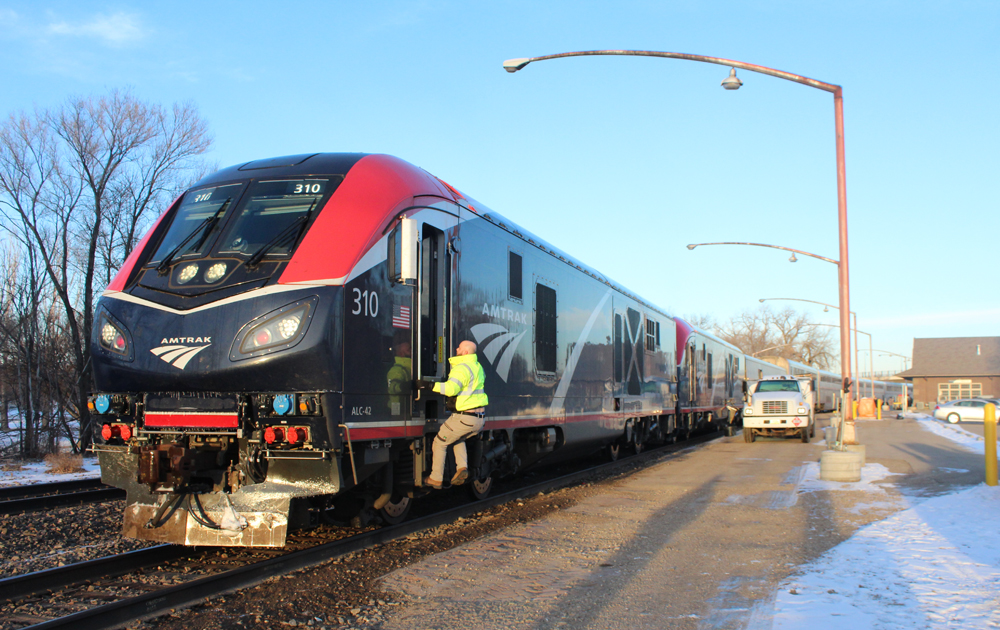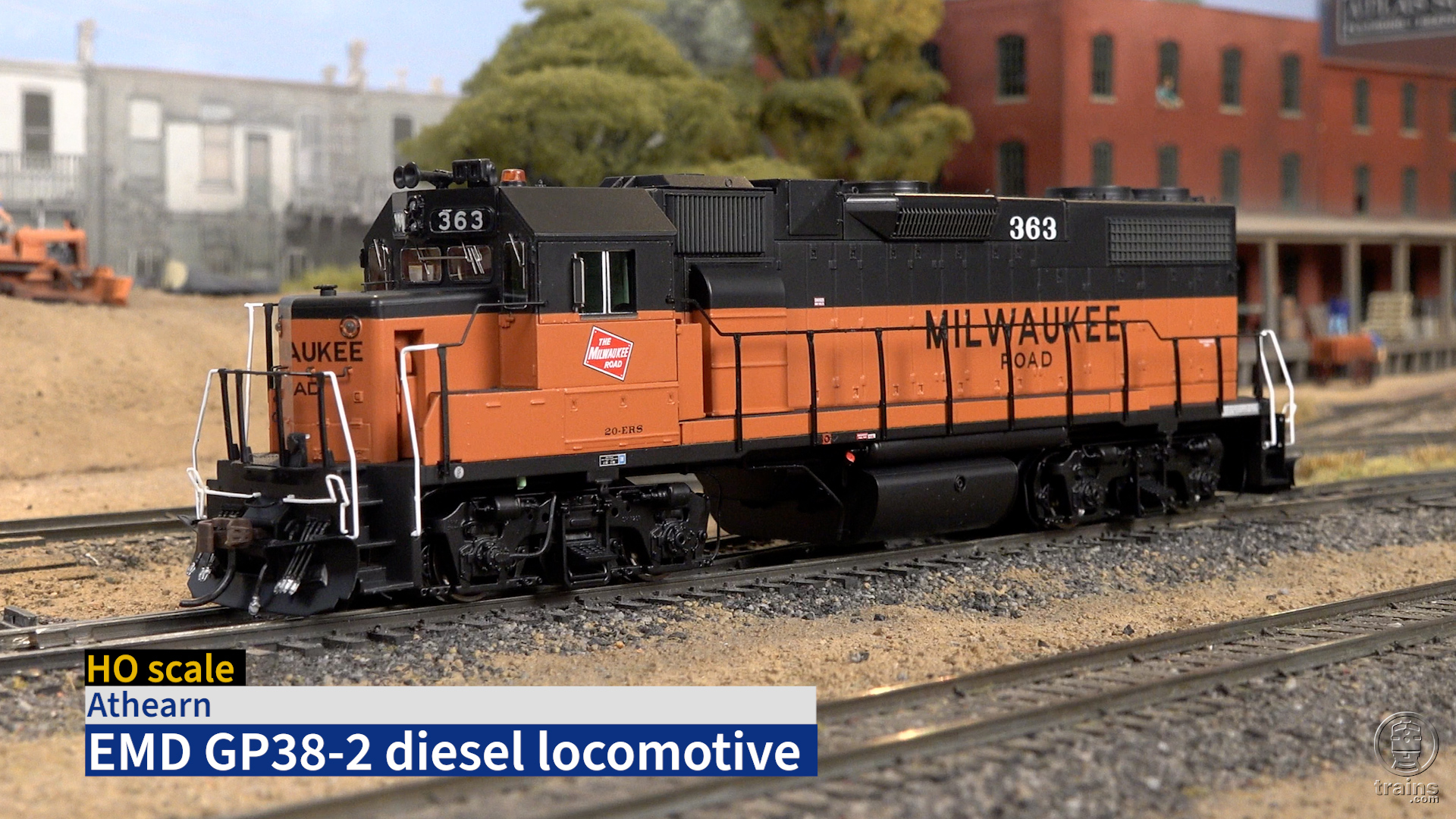
CHICAGO — The Amtrak locomotives that sustained mid-route failures on the Empire Builder in December, stranding the eastbound train in rural Minnesota, are undergoing software and hardware modifications intended to prevent the problems from recurring.
Responding to a Trains News Wire inquiry asking Amtrak why the Builder didn’t operate west of the Twin Cities for more than a week [see “Weather cancellations impact Amtrak and its western network,” News Wire, Jan. 6, 2023], Siemens acknowledged that issues have been identified and are being rectified.
In a statement to News Wire, a Siemens spokeswoman says, “Over the course of the past couple of weeks, Siemens Mobility has been working closely with Amtrak to identify the root cause of a number of isolated incidents of ALC42 power loss occurring under very specific and unusually extreme circumstances, where the locomotive experiences drastic changes in temperature. As a result, we’ve identified both a software solution and an additional hardware improvement that will eliminate the issue experienced. The software update has been implemented to the entire fleet, greatly reducing the potential for incidents. The hardware modification, replacement of a pipe, will be completed as quickly as possible. The [issues were] not encountered on other Charger locomotives, which have different power arrangements than the long-distance ALC42 locomotives.”
She adds, “Given that the ALC42 is a new addition to the Amtrak fleet, Siemens is providing Amtrak with additional support and training regarding the operation and maintenance of the locomotives, to help eliminate downtime and optimize operations.”
Amtrak is taking delivery of 125 ALC42s, a 4,200-hp, long-distance version of the Charger series. The units have larger fuel tanks and more head-end power capability than the 4,400-hp SC44s purchased by Midwest states, California, and Washington for regional trains. After testing, the locomotives first entered revenue service exclusively on the Empire Builder last February [see “Amtrak finalizes order … ,” Feb. 8, 2022].
The units have usually been paired with General Electric P42s, the locomotives they are set to eventually replace, as assignments expanded to the Capitol Limited and City of New Orleans. Though they have often run solo on the Builder, a P42 trailed the three ALC42s that all failed in subzero temperatures and blowing snow on Dec. 20, so the train never lost head-end power during the day-long delay while a BNSF freight locomotive came to the rescue [see “Amtrak cancels more trains …,” News Wire Dec. 22, 2022].














The SC44 Chargers assigned to Chicago have been poor performers in the cold as well, multiple failures. Its no F40 yet.
Would someone explain the phrase used in the article “a number of isolated incidents”?…..
Consider a passenger locomotive has to be able to operate in temperatures from -40F to +120F.
Then provide power to the train for HVAC, interior lights, pump water and sewage.
The locomotive also has to provide compressed air for brakes. What else?
To quote a Star Trek character, “The more complicated the plumbing, the easier for the drain to get stopped up”.
The old E and F units were reliable, tough and durable and pleasing to the eye and had that beautiful streamlined look to them just as much as the classic automobiles of the 50s and 60s. Today’s equipment leaves much to be desired. It neither looks great nor will last the many years that those old engines did. I can’t imagine these new Siemens units lasting 60 or 70 years even to pull excursion trains. But then again there is an ulterior motive to all this You have to keep buying new equipment every so many years to replace 15 and 20 year old locos that wear or burn out. The manufacturers would rather build and replace existing equipment to increase their profits. You can’t make money or please stockholders with equipment that will last for 50 or 60 years.
Joseph C. Markfelder
Also, these are highly complex, and from what I hear, Siemens US keeps futzing with the numerous computer system’s software, poor quality, poor testing. Each loco on a train apparently needs the exact same version of all the software, and if one little thing goes wrong, everything apparently gets shut down. Crews can’t do temporary workarounds to keep trains moving.
That is Microsoft and Apple’s playbook to a tee!
Exactly! Over priced, over complicated, bricks on wheels.
Question:
Why not use the ALC42s on the Sunset Limited & Southwest Chief until everything is corrected?
Continue to use the P42s on the more “winter” routes in the interim…
Yep, never ever had below zero blizzard conditions across the northern US ever. Amtrak should have tested a few F125’s before committing the whole house to Siemen’s. Just waiting for the day we read about a palm being greased in all this.
Mr. Shoemaker, you sure hit the nail on the head with that last thought. Isn’t it just a leetle bit strange that all the recent contracts for new locomotives and passenger cars has been with Siemens?
And the GP40P’s built for CNJ in 1968 are still in service for CNJ successor NJT.
Converted to HEP and rebuilt a few times, but mostly the same locomotive
Despite Amtrak paying a premium to Siemens for training and support on its new power, is Amtrak’s persistent failure to competently operate this new equipment a direct result of corporate management’s inexperience and rush to downsize its seasoned maintenance work force to drastically reduce its payroll exposure during the pandemic?
How much more is Amtrak now spending in its rush to recruit and train a new maintenance workforce? Will Amtrak’s corporate management cover these higher expenses by using the plug in the budget initially meant for their bonuses?
Amtrak continues to pay a heavy price for its inability to replace the hands-on competence of Graham Claytor and David Gunn; compounded by a Board lacking the requisite experience to provide true stewardship and demand accountability.
Claytor and Gunn were amazing. I met Gunn when he was at NYCTA – I liked that if he made a mistake, he owned up to it. As to Siemens, these locos were ‘designed’ in Europe but built with US components that don’t seem to work well, plus Siemens apparently has complete control over them, and making things worse, they are very complex and highly computerized.
“Unusually extreme”?
Not in America.
Also, How often must one click on “Sign in,” ensure my name and password are correct, click on “Keep me signed in” in the Sign In box, and click on “Sign in” before I actually STAY signed in?
Despite Amtrak paying Siemens for training and support, is Amtrak’s persistent failure to competently operate this new equipment a direct result of its rush to downsize its seasoned maintenance work force to drastically reduce its payroll exposure during the pandemic?
How much more is Amtrak now spending in its rush to recruit and train a new workforce?
Will Amtrak’s corporate management cover these higher costs by using the plug in the budget initially meant for their bonuses?
Amtrak continues to pay a heavy price for its inability to replace the competence of Graham Claytor and David Gunn; compounded by a Board lacking the requisite experience to provide true stewardship and demand accountability.
The EPA’s onerous T4 regulations have destroyed the domestic diesel locomotive market. Until they are repealed (I’m not holding my breath) Amtrak should dive into the rebuilding market. There are a lot of good freight diesels sitting in storage lines that could be modified for passenger operations. That’s obviously not an ideal solution but government overreach, environmental zealotry, and utter contempt of anything, including common sense and cost/benefit analysis, that conflicts with the elitist political agenda are dismissed out of hand.
Is there any evidence at all that T4 regs were related to these problems?? I am quite sure that the hundreds (thousands?) of T4 freight locos are not suffering these problems.
Where is a good old, simple, tough as nails E8 when you need it. Designed by men, not software writers, it has now become a part of today, with our machines becoming so overly complex, and driven by “software”…….
The first generation of diesel locomotives had their own problems as well. Most of us here are too young (believe it or not) to have witnessed the era when EMD, and others, provided “diesel riders” on many passenger trains to analyze problems that would occur and, perhaps, make adjustments to keep them running.
One retiree that I know worked as a diesel rider for EMD several years before the program was eliminated in the 1960s. His specialty was electrical systems. He experienced many relay failures during his time as a rider. The fix sometimes employed a flag stick strategically poked into the electrical cabinet.
Ya, but I am old enough to remember E units slugging their way in to Lincoln in the worst of Nebraska blizzards, with or without “diesel riders”…….
Maybe it’s time to stop putting all the computer crap on locomotives. Computers equal no reliability in my experience.
One would think in this age of modern management and technological know how, that a new loco design could be thoroughly tested before being deployed. Did the decade of Fs and Es produce as many stranded trains? I’m embarrassed for Siemens, first too many problems with the new coaches and now this.
Maybe it’s time to get GE and EMD back in the game?
They’ve both made duds too
Doubt that they’ll come back to the passenger market. EMD tried with the F125 but it only sold to Metrolink, and MPI tried (and probably still is trying) with the MP54AC, but I think GO was the only customer. European manufacturers (mainly Siemens) nowadays just make so much passenger equipment and at good quality too, and the Chargers that Siemens build just seem to be a good do-it-all locomotive for the passenger railroads like Amtrak, Via, Brightline, Coaster, ETC., much like the F40PHs. So I don’t think that GE and EMD will come back to the game as of now.